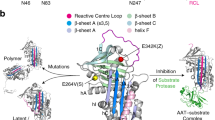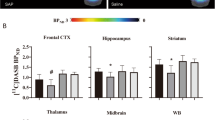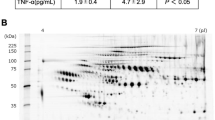Abstract
The reactive site loop of the serpin family of serine proteinase inhibitors is flexible and can adopt a number of diverse conformations. A 2.9 Å resolution structure of α1-antitrypsin—the principal proteinase inhibitor in human plasma—shows the loop in a stable canonical conformation matching that found in all other families of serine proteinase inhibitors. This unexpected finding in the absence of loop insertion into the body of the molecule favours a two-stage mechanism of inhibition and provides a model for the heparin activation of antithrombin. The β-pleated strand conformation of the loop also accounts for the polymerization of the serpins in disease and for their association with other β-sheet structures, most notably the β-amyloid of Alzheimer's disease.
This is a preview of subscription content, access via your institution
Access options
Subscribe to this journal
Receive 12 print issues and online access
$259.00 per year
only $21.58 per issue
Buy this article
- Purchase on SpringerLink
- Instant access to full article PDF
Prices may be subject to local taxes which are calculated during checkout
Similar content being viewed by others
References
Loebermann, H., Tokuoka, R., Deisenhofer, J. & Huber, R. Human α1-proteinase inhibitor. Crystal structure analysis of two crystal modifications, molecular model and preliminary analysis of the implications for function. J. Mol. Biol. 177, 531–556 (1984).
Huber, R. & Carrell, R.W. Implications of the three-dimensional structure of α1-antitrypsin for structure and function of serpins. Biochemistry 28, 8951–8966 (1989).
Potempa, J., Korzus, E. & Travis, J. The serpin superfamily of proteinase inhibitors: structure, function, and regulation. J. Biol. Chem. 269, 15957–15960 (1994).
Stein, P.E. et al. Crystal structure of ovalbumin as a model for the reactive centre of serpins. Nature 347, 99–102 (1990).
Mottonen, J. et al. Structural basis of latency in plasminogen activator inhibitor-1. Nature 355, 270–273 (1992).
Carrell, R.W., Stein, P.E., Fermi, G. & Wardell, M.R. Biological implications of a 3Å structure of dimeric antithrombin. Structure 2, 257–270 (1994).
Wei, A., Rubin, H., Cooperman, B.S. & Christianson, D.W. Crystal structure of an uncleaved serpin reveals the conformation of an inhibitory loop. Nature Struct. Biol. 1, 251–258 (1994).
Schreuder, H.A. et al. The intact and cleaved human antithrombin III complex as a model for serpin-proteinase interactions. Nature Struct. Biol. 1, 48–54 (1994).
Wright, H.T. & Scarsdale, J.N. Structural basis for serpin inhibitor activity. Proteins 22, 210–225 (1995).
Lomas, D.A., Evans, D.L., Stone, S.R., Chang, W.-S.W. & Carrell, R.W. The effect of the Z mutation on the physical and inhibitory properties of α1-antitrypsin. Biochemistry 32, 500–508 (1993).
Mast, A.E., Enghild, J.J. & Salvesen, G. Conformation of the reactive site loop of α1-proteinase inhibitor probed by limited proteolysis. Biochemistry 31, 2720–2728 (1992).
Kwon, K.-S., Kim, J., Shin, H.S. & Yu, M.-H. Single amino acid substitutions of α1-antitrypsin that confer enhancement in thermal stability. J. Biol. Chem. 269, 9627–9631 (1994).
Sidhar, S.K., Lomas, D.A., Carrell, R.W. & Foreman, R.C. Mutations which impede loop/sheet polymerisation enhance the secretion of human α1-antitrypsin deficiency variants. J. Biol. Chem. 270, 8393–8396 (1995).
Song, H.K., Lee, K.N., Kwon, K.-S., Yu, M.-H. & Suh, S.W. Crystal structure of an uncleaved α1-antitrypsin reveals the conformation of its inhibitory reactive loop. FEBS Lett. 377, 150–154 (1995).
Bode, W. & Huber, R. Ligand binding: proteinase-protein inhibitor interactions. Curr. Op. Struct. Biol. 1, 45–52 (1991).
Wilczynska, M., Fa, M., Ohlsson, P.-I. & Ny, T. The inhibition mechanism of serpins. Evidence that the mobile reactive centre loop is cleaved in the native protease-inhibitor complex. J. Biol. Chem. 270, 29652–29655 (1995).
Shore, J.D. et al. A fluorescent probe study of plasminogen activator inhibitor 1: Evidence for reactive center loop insertion and its role in the inhibitory mechanism. J. Biol. Chem. 270, 5395–5398 (1995).
Engh, R., Huber, R., Bode, W. & Schulze, A.J. Divining the serpin inhibition mechanism: a suicide substrate ‘spring’? Trends in Biotech. 13, 503–510 (1995).
Olson, S.T. & Björk, I. Thromin, Structure and Function (eds. Berliner, LJ.) 159–217 (Plenum Press, 1992).
Gettins, P.G.W. et al. Transmission of conformational change from the heparin-binding site to the reactive centre of antithrombin. Biochemistry 32, 8385–8389 (1993).
van Boeckel, C.A.A., Grootenhuis, P.D.J. & Visser, A. A mechanism for heparin-induced potentiation of antithrombin III. Nature Struct. Biol. 1, 423–425 (1994).
Owen, M.C., Brennan, S.O., Lewis, J.H. & Carrell, R.W. Mutation of antitrypsin to antithrombin. α1-antitrypsin Pittsburgh (358 Met to Arg), a fatal bleeding disorder. N. Eng. J. Med. 309, 694–698 (1983).
Jordan, R.E., Nelson, R.M., Kilpatrick, J., Newgren, J.O., Esmon, P.C. & Fournel, M.A. Inactivation of human antithrombin by neutrophil elastase. Kinetics of the heparin-dependent reaction. J. Biol. Chem. 264, 10493–10500 (1989).
Eriksson, S., Carlson, J. & Velez, R. Risk of cirrhosis and primary liver cancer in alpha1-antitrypsin deficiency. N. Eng. J. Med. 314, 736–739 (1986).
Lomas, D.A., Evans, D.L., Finch, J.T. & Carrell, R.W. The mechanism of Z α1-antitrypsin accumulation in the liver. Nature 357, 605–607 (1992).
Lomas, D.A., Finch, J.T., Seyama, K., Nukiwa, T. & Carrell, R.W. α1-antitrypsin Siiyama (Ser53→Phe); further evidence for intracellular loop-sheet polymerisation. J. Biol. Chem. 268, 15333–15335 (1993).
Lomas, D.A. et al. Alpha1-antitrypsin Mmalton (52Phe deleted) forms loop-sheet polymers in vivo: evidence for the C sheet mechanism of polymerisation. J. Biol. Chem. 270, 16864–16870 (1995).
Ma, J., Yee, A., Brewer jr., H.B. & Potter, H. Amyloid-associated proteins α1-antichymotrypsin and apolipoprotein E promote assembly of Alzheimer β-protein into filaments. Nature 372, 92–94 (1994).
Fraser, P.E., Nguyen, J.T., McLachlan, D.R., Abraham, C.R. & Kirschner, D.A. α1-antichymotrypsin binding to Alzheimer A beta peptides is sequence specific and induces fibril disaggregation in vitro. J. Neurochem. 61, 298–305 (1993).
Janciauskiene, S., Eriksson, S. & Wright, H.T. A specific structural interaction of Alzheimer's peptide Aβ1-42 with α1-antichymotrypsin stimulates amyloid fibril formation. Nature Struct. Biol. 3, 668–671 (1996).
Hopkins, P.C.R., Carrell, R.W. & Stone, S.R. Effects of mutations in the hinge region of serpins. Biochemistry 32, 7650–7657 (1993).
Leslie, A.W.G. Recent changes to the MOSFLM package for processing film and image data. In Joint CCP4 and ESF-EACMB Newsletter on Protein Crystallography (Daresbury Laboratory, Warrington, UK, 1992).
Colloborative Computational Project Number 4. The CCP4 Suite : programs for protein crystallography. Acta Crystallogr. D50, (1994).
Navaza, J. AMoRe : an automated package for molecular replacement. Acta Crystallogr. A50, 157–163 (1994).
Brünger, A.T. XPLOR Version 3.1 Manual (Yale Univ., USA, 1993).
Abrahams, J.P. Likelihood-weighted real space restraints for refinement at low resolution. In Macromolecular Refinement, Proceedings of the CCP4 Study Weekend In the press (Daresbury Laboratory, Warrington, UK, 1996).
Tronrud, D.E., Ten Eyck, L.F. & Matthews, B.W. An efficient general purpose least-squares refinement program for macromolecular structure. Acta Crystallogr. A43, 489–501 (1992).
Kraulis, P.J. MOLSCRIPT: a program to produce detailed and schematic plots of protein structures. J. appl. Crystallogr. 24, 946–950 (1991).
Laskowski, R.A., MacArthur, M.W., Moss, D.S. & Thornton, J.M. PROCHECK: a program to check the stereo chemical quality of protein structures. J. Appl. Crystallogr. 26, 283–291 (1994).
Author information
Authors and Affiliations
Rights and permissions
About this article
Cite this article
Elliott, P., Lomas, D., Carrell, R. et al. Inhibitory conformation of the reactive loop of α1-antitrypsin. Nat Struct Mol Biol 3, 676–681 (1996). https://doi.org/10.1038/nsb0896-676
Received:
Accepted:
Issue date:
DOI: https://doi.org/10.1038/nsb0896-676
This article is cited by
-
Nanomedicine platform for targeting activated neutrophils and neutrophil–platelet complexes using an α1-antitrypsin-derived peptide motif
Nature Nanotechnology (2022)
-
Reactive centre loop dynamics and serpin specificity
Scientific Reports (2019)
-
Mineralization of alpha-1-antitrypsin inclusion bodies in Mmalton alpha-1-antitrypsin deficiency
Orphanet Journal of Rare Diseases (2018)
-
A novel model and molecular therapy for Z alpha-1 antitrypsin deficiency
Mammalian Genome (2012)
-
Recombinant human alpha-1 proteinase inhibitor: towards therapeutic use
Amino Acids (2006)



